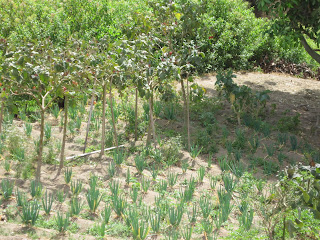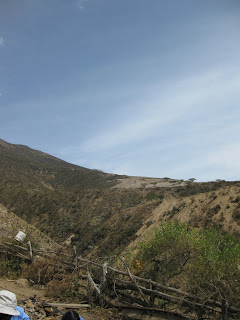It is with great sadness that I report that the camera that I took with me on this adventure was stolen, thus there are no pictures.
La Mama Negra is, in fact, two festivals back to back -- each one put on by a rival church in the town of Latacunga, about 90km south of Quito. I went to the first one (which claims to be the original, and is put on by the people), which started Wednesday evening and ended Friday morning. The next one began Friday evening and will end on Sunday.
Though the distance is not far, the trip from one end of Quito to the other by itself took over an hour, though it only cost 50cents. From the southern end of the city, I got on a great bus decked out with figurines of Jesus and Che Guevara, blasting some terrible 90's rock. We tore down the road and were in Latacunga by mid-afternoon. I got off the bus, grabbed my backpack, headed past the teaming main market, asked for directions, and arrived at my hostel to the ringing of church bells.
There, I met Sam, a friend of a friend, who was to be my fabulous festival partner. The first thing we did was go up to the roof of the hostel, climb over a wall and up onto the roof of a building under construction, from which you could see Cotopaxi in all her splendor (the giant mountain, to which La Mama Negra is dedicated, and for which the province, of which Latacunga is the capital, is named.) You could also see the town spread out below, bedecked in red tile roofs and topped off by steeples.
The first parade started soon after, and we were ready. Perched on the curb, surrounded by little kids and elderly ladies, we watched as first the bands, then the dance troops, and then the crazy masked and costumed characters began to flood down the street. Bright flags and streamers hung down above the narrow roads, each end attached to the sides of white plastered buildings.
Trumpets blared, angels and demons rode by on horseback, white bird-men danced around and battered you with their wings, shamans came by and "cleansed" you with spit, alcohol, herbs, and sticks, and vendors strolled around selling deep-fried pig skins in sheets. There were military bands, bus company bands, family bands, town bands, church bands, and school bands. There were dancers dressed in traditional clothes, in bright ponchos, in sandals, in elaborate hats, in white robes, in yellow dresses, with face paints, with masks, with sashes, and jugs of juice and alcohol. There were people whistling, singing, praying, yelling, and shooting off guns. There were tourists taking pictures and people joining the parade.
There were old men dancing and young men carrying giant offerings to Cotopaxi. These offerings were giant cooked pigs on stakes, attached to a round base. Attached to the pig and the base were staked chickens, rabbits, qui, bottles of liquor, packs of cigarettes, pictures of the Virgin Mary, Ecuadorian flags, fruit, and the occasional soccer team logo. I can't imagine that any of these giant constructions weighed much less than I do. Behind the sweating, painted, costumed man carrying these offerings, came a troop of supporters. One carried a small table, which every five minutes or so would be placed right under the bottom of the offering so that the carrier could rest with the table taking the weight of the offering. The others would be other men in matching costumes (who mostly either looked concerned, were dancing enthusiastically, or were helping the carrier, and everyone in the area, get (more) drunk) or the mom/sister/wife who carried a jug of water.
And, of course, there was La Mama Negra. An important (authority) figure in the town, dressed as a large black lady, with an elaborate wig and matching baby doll, who rode around with no apparent concern for the direction of the parade and squirted people with sour milk and foul alcoholic beverages.
The parade went all over one part of town, making a circle, and ending up a little after dark in the square where it began. Sam and I made some friends, and after a short wait, they took us to the park down the street where we witnessed, at close proximity, an incredible fireworks display. If you have never seen fireworks in Ecuador, one of the favorite ways to set them off is by making a giant bamboo contraption, where after the bottom fuse is lit, it starts a chain reaction of sparks that light other fuses so that soon the whole contraption is one big burning, sparking, booming, colorful, spinning mass that sometimes ends in a tremendous shower. It was spectacular.
The next day after (well, really it started during, competing with) a mass and a reenactment of something to do with two Mama Negras, military men, priests and flowers, there were two more parades, which got progressively crazier and more outlandish. The first went all the way up to the top of the big hill, and we met it half-way back down, on the steep cobble-stone street. The endurance of the dancers and musicians was amazing. The sun was hot and the crowd boisterous. People come from all over the country for this, and they were there to party.
Sam and I made some more friends and were kindly invited back to someone's house for lunch. It turns out, it was a lunch for some of the dancers, and after we finished some tasty soup and a huge plate of rice and chicken, we were pulled into an impromptu dance party. Complete with a band. Free lunch and dancing with a family of strangers might be one of the best things that can happen to poor traveling college students.
After lunch, which was actually late afternoon, we went to the main big plaza of the town to wait for the next parade to go by. It turned out to be a longer wait than we had anticipated, but it was still festive and our friends had a good time asking us questions about ourselves and teaching us words in Quichua.
By the time the parade finally got to us, it was getting dark and chilly. Nonetheless, there were hundreds of people on the street and the noise was unbelievable. Men in dresses, wigs, and masks, went around actually whipping the crowd to keep them out of the way of the dancers, and other men in costume came around giving out Loas. Loas are poems like limericks that rhyme and are usually crude and funny. After they give you your Loa (which is supposed to be made up on the spot) they douse you in, and often make you drink, aguariente -- a type of moonshine. Please picture Sam (who is tall, blond, and blue eyed) and me standing in a crowd of Ecuadorians. Boy did we stand out. By the end of the night, we were both covered in bad milk, nasty moonshine, spit, beer, and other assorted "cleansers". Imagine how we smelled. Still, we had a good time, and made it safely back to our hostel, to the relief of the kind ladies who ran it.
Friday morning we bought bread filled with cheese and a large cup of freshly squeezed orange juice and had breakfast on the roof. We heard the military band playing all sorts of songs, including the national anthem, in the main square, and what sounded like a hundred children singing out from behind a school wall. We parted ways after crossing the river on the edge of town, and I caught the bus back to Quito, arriving home after lunch in dire need of a shower.

 (Below) The valley the ruins look out over. We're near La Mitad del Mundo, at the end of Quito's sprawl. Look how dry the area is. Interestingly, there are a lot of acia trees that remind me of the route out to Mombasa in Kenya. Most of the flat fields you can see are corn fields, and all of the houses are cement brick.
(Below) The valley the ruins look out over. We're near La Mitad del Mundo, at the end of Quito's sprawl. Look how dry the area is. Interestingly, there are a lot of acia trees that remind me of the route out to Mombasa in Kenya. Most of the flat fields you can see are corn fields, and all of the houses are cement brick. On top of the walls (that have been restored) there's a lot of pumice stone, which is a volcanic rock that is full of air and weighs next to nothing.
On top of the walls (that have been restored) there's a lot of pumice stone, which is a volcanic rock that is full of air and weighs next to nothing. 
















 After our visit to Yachana Wasi, Diego took us up the side of the mountain to Don Virgilio's goat pen. There were actually three pens; one for all the sheep, their lambs, the goats, and their kids, one for the big papa pig, and one for the mama sow and her piglets. Cute and super smelly.
After our visit to Yachana Wasi, Diego took us up the side of the mountain to Don Virgilio's goat pen. There were actually three pens; one for all the sheep, their lambs, the goats, and their kids, one for the big papa pig, and one for the mama sow and her piglets. Cute and super smelly.
 The manure of the goats and sheep (below) was shoveled into these sacks (above).
The manure of the goats and sheep (below) was shoveled into these sacks (above).
 And then, one by one, these 75lb bags were carefully carried down on bent backs. I think I made two trips before wiping out. These women (and my dad) did trip after trip until all 83 sacks were piled at the bottom of the hill ready to be picked up by a big truck.
And then, one by one, these 75lb bags were carefully carried down on bent backs. I think I made two trips before wiping out. These women (and my dad) did trip after trip until all 83 sacks were piled at the bottom of the hill ready to be picked up by a big truck. 























